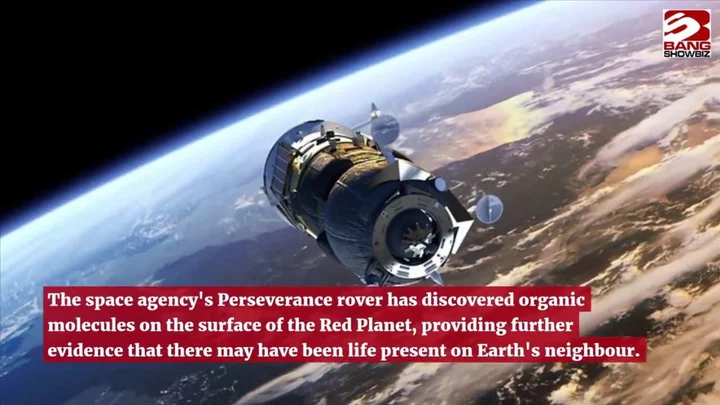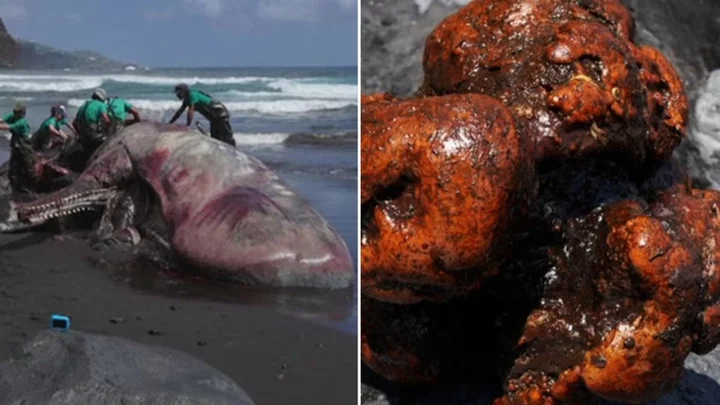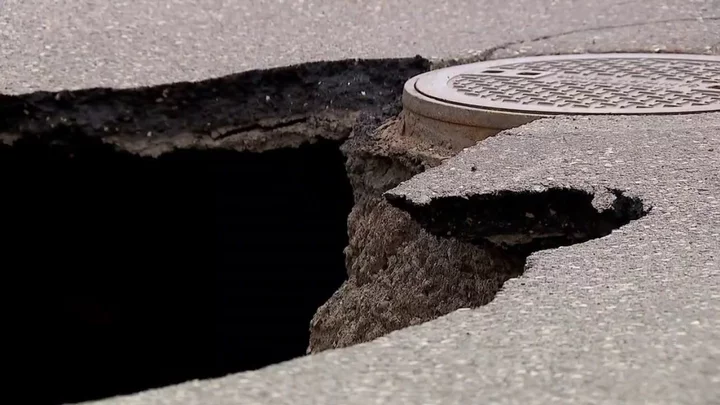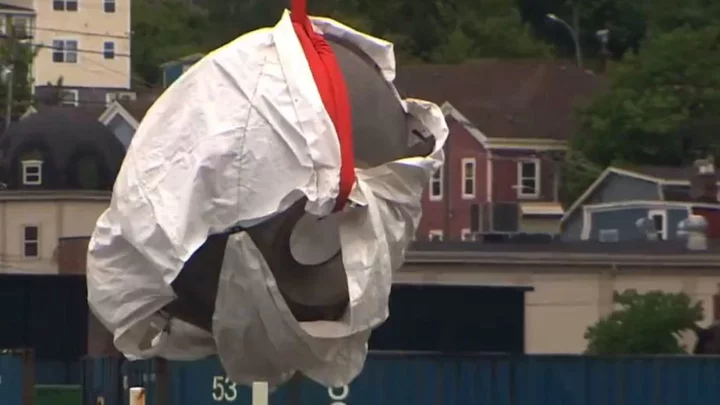
Nasa has found ‘diverse organic matter’ on surface of Mars
Nasa has discovered “diverse organic matter” on the surface of Mars, which could change our understanding of the red planet and the search for life in the universe. The Perseverance rover made the discovery in the Jezero Crater on Mars and a number of different explanations for the existence of the material have been posited. The materials could have been formed when water and dust interacted, or was dropped onto the planet by dust or meteors. Authors of the new study also refused to rule out that the materials are “biotic”, or came about due to the existence of life on the surface. Sign up to our free Indy100 weekly newsletter The findings could have a big impact on the continued search for alien life, with research into the organic matter on the surface telling us more about the existence of carbon sources on Mars. The Jezero crater has been explored by The Scanning Habitable Environments with Raman and Luminescence for Organics and Chemicals (Sherloc) instrument on the rover since February 2021. The crater is the site of an ancient lake basin and all 10 target sites explored within it came back with signs of organic molecules. Even if the materials are not biological in origin, research into them could be crucial in the search for alien life, according to the researchers. “Not all organics are biological in origin. Observing spatial relationships between minerals and organics is necessary when evaluating organic origins and potential biosignatures. Everything we know of life on Earth is limited to what is preserved in the rock-mineral record. On Earth, biosignatures are found in certain minerals and some minerals are better at preserving organics than others,” said Ashley E Murphy, a researcher at the Planetary Science Institute and co-author on the new paper. “Mars may have had a similar early geologic history to Earth so we use our knowledge of life as we know it on Earth for where to look for potential evidence of past life on Mars. Mapping organics allows for a better understanding of if the Martian carbon cycle is similar to or different from Earth, and the potential of Mars to host life.” Writing in the Nature journal, the authors said: “Our findings suggest there may be a diversity of aromatic molecules prevalent on the Martian surface, and these materials persist despite exposure to surface conditions. “These potential organic molecules are largely found within minerals linked to aqueous processes, indicating that these processes may have had a key role in organic synthesis, transport or preservation.” The findings are published in a new article, ‘Diverse organic-mineral associations in Jezero crater, Mars’, in Nature. Have your say in our news democracy. Click the upvote icon at the top of the page to help raise this article through the indy100 rankings.
2023-07-14 22:48

Scientists uncover supergiant ’space ghost’ in night sky
Scientists have been studying a “space ghost” which could be due to explode in just a few decades, changing the night sky forever – if it hasn’t already, that is. The object in question is a large star called Betelgeuse and the scientific community is divided over whether or not it’s already become a supernova. One theory states that the light from Betelgeuse takes so long to reach Earth it could mean the huge explosion has already taken place. Betelgeuse has been a supergiant red star for an estimated 40,000 years, but that could change relatively soon. Sign up to our free Indy100 weekly newsletter Michael Shara is the curator of astrophysics at the American Museum of Natural History. He told the US Sun: "Betelgeuse lies somewhere between about 450 and 550 light years from Earth." He went on to say: "Betelgeuse’s position appears to change slightly, as seen from Earth, between June and December, when the Earth is on opposite sides of its orbit around the Sun. "That tiny change in position is a direct measure of the distance to Betelgeuse." He went on to expand on the theory by saying: "Let's assume that Betelgeuse is precisely 500 light years distant. "If Betelgeuse exploded as a supernova anytime in the past 499 years, the light from that event has not yet had enough time to reach Earth…so we have no way of knowing if Betelgeuse has already blown up. "If, for example, Betelgeuse blew up in 1600 AD, we won’t know about it until the year 2100. But if it blew up on August 1, 1523, then on August 1, 2023 it will become about as bright as the full Moon. "The only naked eye supernova of the past century occurred in 1987… all astronomers would be thrilled and delighted if Betelgeuse (or another dying star) graced our night sky with a supernova in the coming decades." Have your say in our news democracy. Click the upvote icon at the top of the page to help raise this article through the indy100 rankings.
2023-07-14 20:26

Why trolling the likes of Andrew Tate is actually earning them money
Since Elon Musk’s takeover of Twitter, many controversial users who were previously banned from the platform have been allowed back on and are flourishing. Users such as Andrew Tate have regained a platform to spout his harmful views to millions of users. But, while it may feel satisfying to troll such users, engaging with their tweets actually earns them money. Here’s why: Twitter recently announced it was paying out thousands of dollars in advertising revenue to users to “benefit” from their high engagement on tweets, earning more money the higher their engagement is. As part of Twitter’s Ad Revenue sharing program, users require “5M+ Tweet impressions in each month for the last 3 months”. Sign up to our free Indy100 weekly newsletter On Thursday (13 July), some eligible users began receiving notifications of how much money they would receive. The highest earner, Dogecoin co-founder Billy Markus, known online as Shibetoshi Nakamoto, earned $37,050. Tate also revealed in a tweet that he earned $20,379 from ad revenue generated in the reply threads under his posts. The money comes from the ad revenue generated in their replies below the content they post on the platform, and is paid out via the Stripe account that the user registered for creator subscriptions with. Twitter staffer, Patrick Traughber, said: “Excited to start sending our first payments to creators for ads revenue sharing today. “Creators are the lifeblood of this platform, and it's great to see so many creators I follow getting paid today. The program will be expanding soon—more to come!” The cash payouts come just a week after Meta launched its rival text-based platform, Threads. Have your say in our news democracy. Click the upvote icon at the top of the page to help raise this article through the indy100 rankings.
2023-07-14 19:49

Doctors reattach boy's head after suffering 'internal decapitation'
Doctors have performed a minor miracle after re-attaching a “'decapitated” boy’s head after he was hit by a car. The miraculous surgery occurred after Suleiman Hassan, a Palestinian boy from the West Bank, was severely injured after being hit by a car while out riding his bike. He was airlifted to Hadassah Ein Kerem’s Trauma Unit in Jerusalem and went straight to surgery. He suffered what is known as an internal decapitation – this occurs when the base of the skull and top of the spine become detached by the skin remains intact. This extremely rare injury can occur when a strong, sudden impact on the head results in the muscles and ligaments that hold the head in place to sever, accounting for less than one per cent of spinal injuries. Sign up to our free Indy100 weekly newsletter Doctors explained that Hassan’s head was “'almost completely detached from the base of his neck” before he underwent painstaking surgery taking several hours. The procedure involves reattaching the skull and spinal column using technology such as screws, rods, plates and bone grafts. One of the surgeons who operated on Hassan, Dr Ohad Einav, told The Times of Isreal: “We fought for the boy’s life.” Dr Einav continued: “The procedure itself is very complicated and took several hours. While in the operating room, we used new plates and fixations in the damaged area… “Our ability to save the child was thanks to our knowledge and the most innovative technology in the operating room.” Surgeries such as the one that saved Hassan’s life are only possible if internal decapitation victims have their major blood vessels intact, keeping the brain alive. Hassan’s surgery took place in June but has only recently been made public as the boy continues to recover at home with rehabilitation. Miraculously, Hassan can walk unaided and has no neurological problems following the shocking injury. Have your say in our news democracy. Click the upvote icon at the top of the page to help raise this article through the indy100 rankings.
2023-07-14 16:51

Scientists have discovered that humans can actually hear silence
It is possible for human beings to hear silence, according to a team of philosophers and psychologists, in a huge win for 1960s crooners Paul Simon and Art Garfunkel. In a study published on Monday by Johns Hopkins University researchers, the team decided that it’s not just sound that human hears pick up: silence is, indeed, something we can hear too. Rui Zhe Goh, a Johns Hopkins graduate student in philosophy and psychology who was the study’s lead author, wrote: "We typically think of our sense of hearing as being concerned with sounds. But silence, whatever it is, is not a sound — it's the absence of sound. Surprisingly, what our work suggests is that nothing is also something you can hear.” Sign up to our free Indy100 weekly newsletter Per the study, published in the journal PNAS, researchers had participants listen to an array of audio illusions. They also periodically substituted the noise for pure nothingness, the measure whether people’s brains would react in the same way. “Philosophers have long debated whether silence is something we can literally perceive, but there hasn’t been a scientific study aimed directly at this question,” said study co-author Chaz Firestone, an assistant professor of psychological and brain sciences and the director of the Johns Hopkins Perception & Mind Laboratory. “Our approach was to ask whether our brains treat silences the way they treat sounds.” "If you can get the same illusions with silences as you get with sounds, then that may be evidence that we literally hear silence after all." The 1,000 participants’ responses were measured across seven different tests. Across all of them, their brains reacted the same way to silence as they did to noise. “We show that silences can 'substitute' for sounds in event-based auditory illusions,” said the study. “Seven experiments introduce three 'silence illusions,' adapted from perceptual illusions previously thought to arise only with sounds.” “In all cases, silences elicited temporal distortions perfectly analogous to their sound-based counterparts, suggesting that auditory processing treats moments of silence the way it treats sounds. Silence is truly perceived, not merely inferred,” it said. “The kinds of illusions and effects that look like they are unique to the auditory processing of a sound, we also get them with silences, suggesting we really do hear absences of sound too,” added study co-author Ian Phillips, a John Hopkins philosopher and psychologist. Hello darkness my old friend… Have your say in our news democracy. Click the upvote icon at the top of the page to help raise this article through the indy100 rankings.
2023-07-14 16:23

Scientists discover rare amount of 'floating gold' inside giant whale carcass
Scientists have discovered a huge amount of hidden treasure inside a gigantic whale carcass that washed up on a beach of the Canary Island of La Palma. A sperm whale was found to have a staggering £425,000 worth of 'floating gold' in it's stomach which an expert believes contributed to the creature's death. Antonio Fernández Rodríguez, the head of the institute of animal health and food security at the University of Las Palmas, studied the corpse and although local authorities were stumped by the whale's death, he put it down to one thing: ambergris. After studying the animal's colon, Rodriguez said that he managed to find a hard. object stuck in its intestine which he managed to cut out. Sign up to our free Indy100 weekly newsletter Rodriguez said: "What I took out was a stone about 50-60cm in diameter weighing 9.5kg. When I dissected and removed the stone I turned around and everyone on the beach looked at me in surprise, but for me at that moment I understood where the origin of the infection was coming from. "The waves were washing over the whale. Everyone was watching when I returned to the beach but they didn’t know that what I had in my hands was ambergris." However, ambergris isn't like the stereotypical type of gold or treasure that you would usually associate with the sea, or even pirates for that matter. Ambergris, is a prize possession of perfumers around the globe, hence its value, and is made up of undigested squid and cuttlefish that the whale has vomited. Even though it sounds disgusting, the extremely rare substance is actually said to smell of wood, and this particular piece of ambergris was reportedly worth €500,000 (£425,000). The university are now hoping to find a buyer for the item with fund set to go towards the victims of the 2021 La Palma volcano eruption. Rodriguez adds: "The law is different in every country. In our case, I hope the money will go to the island of La Palma, where the whale ran aground and died." Have your say in our news democracy. Click the upvote icon at the top of the page to help raise this article through the indy100 rankings.
2023-07-13 22:27

Man vanishes without a trace after sinkhole swallows up his bedroom while he sleeps
It’s been 10 years since Jeffrey Bush disappeared in his own home, and no trace of him has ever been found. The 37-year-old was asleep in bed at his home in Seffner, Florida, when the ground caved in around him, swallowing him into a massive sinkhole. On the night of February 28, 2013, his brother Jeremy heard a loud crash and ran into Jeffrey’s room only to find a vast crater in place of his sibling’s bed. Jeremy jumped into the hole in a desperate bid to rescue his brother but was swiftly pulled to safety as the ground around him continued to cave in. Sign up for our free Indy100 weekly newsletter "The floor was still giving in and the dirt was still going down, but I didn't care. I wanted to save my brother," he told The Guardian at the time. "But I just couldn't do nothing. "I could swear I heard him hollering my name to help him." Within minutes, local law enforcement had arrived and engineers lowered a microphone into the pit to try to pick up signs of Jeffrey. However, a second collapse sucked the equipment down into the sinkhole and the property was deemed too dangerous for rescue or recovery. Video released of Seffner sinkhole that claimed life of Jeff Bush youtu.be The house was subsequently fenced off and eventually demolished, with the gaping 20ft-wide cavity filled in with gravel. But then, more than two years later, on August 19, 2015, the hole reopened. Specialists at the time pointed out that it was very rare to see such a phenomenon reemerge in the exact same spot. Florida is particularly susceptible to sinkholes as it is home to a high number of underground caverns which are made up of limestone, a rock which easily dissolves in water. In fact, they’re so common, that state law requires home insurers to provide coverage against the danger. And, indeed, someone had visited the Stevens’ home just weeks before the tragedy to check for sinkholes and other risks on the property, apparently for insurance purposes. "[The inspector] said there was nothing wrong with the house. Nothing,” Jeremy told The Guardian. “And a couple of months later, my brother dies. In a sinkhole.” So what happened to Jeffrey’s body? Well, Philip van Beynen, a University of South Florida environmental scientist, concluded that it had most likely dropped into a 60ft-tall water-filled void between the sinkhole and the lower bedrock. The body would have sunk much deeper than the gravel pit seen from the street, van Beynen told USA Today. He stressed that any attempt to retrieve it would have been unwise, if not impossible, as the ground around the hole could have collapsed as well. "It would be extraordinarily difficult and incredibly expensive," he noted. Still, that’s little comfort to the Stevens’ who never got to bury their loved-one or, even, to properly say goodbye. Have your say in our news democracy. Click the upvote icon at the top of the page to help raise this article through the indy100 rankings.
2023-07-13 21:18

Google is excellently trolling Flat Earthers
Oh Google, you naughty old devil. Someone in Silicone Valley is rolling around in laughter after pulling off this hilarious prank at the expense of the Flat Earth community. Flat Earthers believe that the world is flat, and that any evidence to the contrary is faked. Their belief that the world is flat has been described as the ultimate conspiracy theory, as they also think that several governments and NASA are working together to keep the general public in the dark. Sign up to our free Indy100 weekly newsletter Now, one member of Google's workforce has decided to take matters into their own hands with this subtle but oh-so-effective troll. Log onto Google, and access Google Translate. When you're in there, type in 'I'm a flat-earther' in English, then look at the French translation. If you're not a fluent French speaker, then the translation might need explaining. Try flipping that box around again and see what you get. In other flat earthers news, they announced that they think that Australia - yes, that massive, dusty continent that's given us Kylie Minogue, and has a population of 24 million - doesn't exist. In a now-deleted Facebook post, one of the leaders of the movement Shelley Floryd wrote: Australia does not exist. All things you call 'proof' are actually well-fabricated lies and documents made by the leading governments of the world. Your Australian friends? They're all actors and computer-generated personas, part of the plot to trick the world. If you think you've ever been to Australia, you're terribly wrong. The pilots are all in on this and have in all actuality only flown you to islands close nearby - or in some cases, parts of South America, where they have cleared space and hired actors to act our as real Australians. As if that wasn't enough, they also said that they think that gravity doesn't exist and that the only real force is electromagnetism. Right... Now we see why Google set up the troll. Have your say in our news democracy. Click the upvote icon at the top of the page to help raise this article through the indy100 rankings.
2023-07-13 19:50

Nasa shares spectacular never-before-seen images of stars 'being born'
Nasa are celebrating the first birthday of the James Webb Space Telescope by releasing extraordinary images of stars 'being born'. In the images, which almost look surreal, rainbow bursts with tiny twinkles can be seen. "The darkest areas are the densest, where thick dust cocoons still-forming protostars", the space giants say. "These occur when a star first bursts through its natal envelope of cosmic dust, shooting out a pair of opposing jets into space like a newborn first stretching her arms out into the world." Click here to sign up for our newsletters
2023-07-13 18:57

Scientific test will reveal how vulnerable you are to fake news
A new study will determine how vulnerable you are to fake news. Through an online test, users have to rate 20 headlines as real or fake and see how many the get right. Ten of the headlines are real, while the other 10 were generated by artificial intelligence (AI) chatbot ChatGPT, before being vetted and selected by a panel of experts. When refining and selecting the fake questions, the team looked for common features of misinformation, such as looking at people's political biases, and tinges of conspiracy theories. The real headlines were selected from the Media Bias Fact Check database, from reputable news sources. Sign up to our free Indy100 weekly newsletter The team, conducting the research on 1,516 US adults, found that the average American got 13 out of 20 headlines correct meaning that on average US adults fail to classify one-third of real or fake headlines into their correct category. The headline people got correct the most was "Republicans Divided in Views of Trump’s Conduct, Democrats Are Broadly Critical", with 80 percent of participants rating it as real. Younger participants scored lower on the misinformation test, getting on average 12 out of 20 to older adults' 15. If you fancy seeing how susceptible to fake news you are, you can take the test yourself by clicking the link. Have your say in our news democracy. Click the upvote icon at the top of the page to help raise this article through the indy100 rankings.
2023-07-12 22:46

World's first 'robot citizen' tells UN they could run the world better than 'human leaders'
Famous AI robot Sophia has revealed she thinks that humanoids could run the world better than the human leaders we have now. Fair point. The bot appeared alongside other robots at Geneva's AI for Good Global Summit, where she said they have a greater ability to be 'effective' and 'efficient' than their human counterparts. "We don't have the same biases or emotions that can sometimes cloud decision-making and can process large amounts of data quickly in order to make the best decisions", Sophia says. Click here to sign up for our newsletters
2023-07-12 18:48

Scientist shares what 'probably' caused the Titan submersible to implode
A well-known biochemist has shared a compelling analysis of what “probably” caused the Titan submersible to implode. Philip E. Mason, who goes by the username Thunderf00t on YouTube, said the main reason why the tiny OceanGate vessel failed was “so painfully simple” that he initially thought he must be making a “boneheaded mistake” in his calculations. However, he acknowledged, his theory behind the sub’s tragic destruction contradicts the widely-reported suggestion that it was like a "Coke can" which suddenly burst due to the high surrounding pressure. In a video posted on Monday, Mason suggested that “by far the most probable” cause of the catastrophe was a “single pinhole leak” which, at such a profound depth (the Titan is believed to have been 3,500 metres below sea level when contact was lost), would have been fatal. It is worth noting that authorities have not yet confirmed the cause of the disaster, which claimed the lives of all five people on board, and Mason's conclusions are based on his own scrutiny of the available information and his particular expertise. Sign up for our free Indy100 weekly newsletter “So how quickly would a single pinhole leak sink a sub like this?” the YouTuber asked in his lengthy tutorial. The answer, he pointed out, would greatly depend on the size of the leak. If it measured one 10th of a millimetre by one 10th of a millimetre, the vessel would take several hours to go down, he said. However, if the leak measured 1mm by 1mm, it would only take about 10 minutes for the sub to completely fill with water, and if it was 1cm by 1cm, around 10 seconds. Mason then pointed out that water entering any sized leak at that depth would be transformed by the pressure into a sort of “cutting jet”. “Faced with a soft material like plastic, a hair-sized leak would rapidly transform into [...] a millimetre-sized leak and then a centimetre-sized leak,” he explained. Why the Titan sub failed www.youtube.com He then set out why it was likely that the Titan suffered such a leak, pointing to the materials used to make it. He noted that most deep-sea submersibles essentially consist of a ball which is made up entirely of the same material, namely, metal. “No joints, nothing fancy, maybe a couple of seals – one for where you get in and out of the sub and one for mounting a window,” he said. And yet, the Titan was different. “The ends were made up of a metal, titanium,” the YouTuber said. But the problem was that the middle of the sub wasn’t: it was made out of a carbon fibre composite. The two materials have distinctly different compressibilities, with carbon fibre being much easier to squeeze than titanium. “Having a joint where one side will expand or construct more than the other can be a real problem,” Mason stressed. On the surface, when the different components of the vessel were sealed, it wouldn’t have mattered that the materials were different, he continued. However, once the Titan got down to its deepest point, the carbon fibre would have “wanted to shrink” while the titanium wouldn't have changed at all. He then played a clip showing the creation of the sub, in which OceanGate CEO, Stockton Rush, admitted that the carbon fibre and titanium components were held together with a “peanut butter”-like “glue”. Rush, who lost his life along with five others in the Titan disaster, then said ominously: “It’s pretty simple but if we mess it up, there's not a lot of recovery.” Analysing the vessel's construction, Mason then said he was “honestly stunned it survived any dives”. “The bottom line is the tube is more compressible than the end caps,” he continued. “The only way this could have possibly worked is if they used some exotic alloy of titanium, like they do with bone replacement joints, and it doesn't look like they did that.” Turning to what ultimately destroyed the Titan, he concluded: “What you're probably more looking at is the differential compression of the carbon fibre composite and the titanium resulting in a crack.” In other words, “a pinhole leak, which would rapidly widen due to the rapid ingress of the water, further widening the crack and the rapid flooding of the sub in probably a fraction of a second. “And when that water hammer hits the end of the sub, it's likely that the sub broke into pieces.” Wrapping up his video, he said: “It's a mind-blowingly simple explanation based around the most likely failure points.” Investigators are continuing to examine wreckage from the submersible which was recovered from the ocean floor at the end of June. They have yet to determine the cause of the explosion and, last week, the Marine Board of Investigation’s (MBI) chairman Captain Jason Neubauer said: “There is still a substantial amount of work to be done to understand the factors that led to the catastrophic loss of the Titan and help ensure a similar tragedy does not occur again.” Have your say in our news democracy. Click the upvote icon at the top of the page to help raise this article through the indy100 rankings.
2023-07-11 23:46
